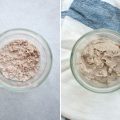When you need a little break from baking, you’ll need to remember that you’re in possession of an active starter, and in order to temporarily place these live bacteria on snooze, your sourdough starter will have to acquire the best storage method to remain alive. Long-term storage in a plastic container at room temperature is completely possible if you intend to bake bread every day. However, for those who wish to store their sourdough starter long-term, then here are some tips to guide you.
Table of Contents
- What is a Sourdough Starter?
- What Happens to Sourdough Starter in the Fridge?
- Benefits of Storing Sourdough Starter in the Fridge
- How to Maintain Sourdough Starter in the Fridge?
- When is Your Sourdough Starter Mature Enough for the Fridge?
- Can You Use Refrigerated Starter Immediately?
- What Happens if I Leave My Sourdough Starter in the Fridge for a Long Time?
- Drying Sourdough Starter
- Can You Freeze Sourdough Starter?
- So, How to Store Starter?
- FAQs
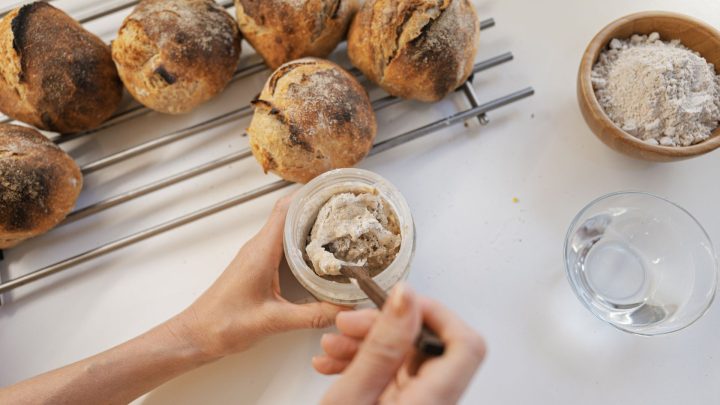
What is a Sourdough Starter?
Essentially, a sourdough starter is a cultivated community of lactic acid bacteria and wild yeast. Both yeast and bacteria feed on the carbohydrates in the flour once hydrated with water and allowed to ferment. You can make sourdough starter using any type of flour you like, whether it is rye flour, whole wheat flour, or all purpose flour.
As long as your starter is fed fresh flour regularly, there should be no problems at all!
What Happens to Sourdough Starter in the Fridge?
Once you place your jar of sourdough starter in the fridge, the dip in temperature will cause your starter to fall asleep.
Your fridge needs to be around 3 degrees before you place your starter inside, as this temperature will slow down the fermentation process. The bacteria present in your starter will continue to work, though the yeast will hibernate. The bacteria will continue to eat so that your starter rises, but this will happen at an extremely slow pace.
You’ll have a somewhat bubbly starter that’ll rise and fall and even produce hooch, when left for a long time.
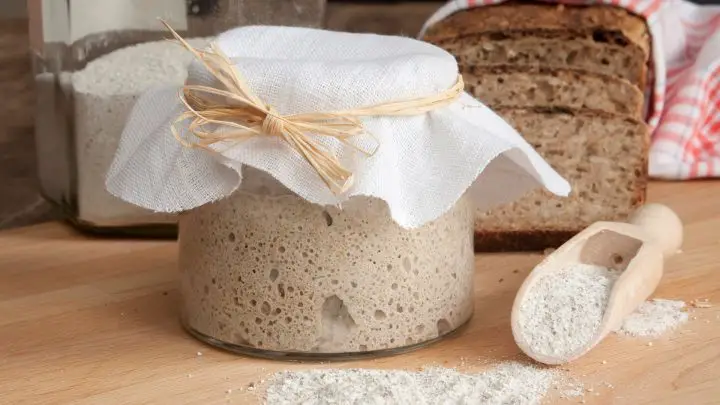
Benefits of Storing Sourdough Starter in the Fridge
Many of us bake regularly. This is why we spend so much of our time ensuring that the starter is fed regularly so that it is ready in time to bake sourdough bread.
But for those of us who wish to take a break from all this sourdough baking, may way to know how to have the sourdough starter stored.
There are many benefits in storing your starter in the fridge:
- For one, you won’t have to feed your starter every day while it’s in the fridge
- A refrigerated sourdough starter doesn’t need fresh flour added for longer periods
- You won’t need to worry about feeding your starter, while you’re busy with daily tasks
- It can encourage happy baking
- You can achieve a sour finish to your delicious sourdough bread
- You can enjoy your vacation stress free
Many bakers affirm that storing their starter in the fridge is much easier, as long as you’re dealing with a mature starter you can forget about it for a while.
However, if you have a new starter, you might want to refrain from placing it in the fridge too soon.
How to Maintain Sourdough Starter in the Fridge?
Before you pop your sourdough starter in the fridge for however long you have planned, you’ll have to feed your starter enough flour and fresh water to keep it going till you’re ready to revive it again.
Try to use a 1:2:2 ratio, meaning feed one part of your starter to 2 parts flour and 2 parts water.
This ratio will guarantee that your sourdough starters have enough food to last them for a while when making the transition from a warm place to a cooler environment.
So grab a clean jar, and take 25g of sourdough starter and feed it with 50g of the same flour, along with 50g of water. Place a lid over your jar and pop this in the fridge, bearing in mind that you won’t need to wait a few hours for your starter to double before putting it away.
Simply feed it, give it a gentle stir and pop it in the fridge. It can remain unfed for up to two weeks, then you’ll have to feed it again, remembering to discard some, then place it straight back into the fridge, unless, of course, your evening plans include baking sourdough bread, then you can wait for your starter to reach room temp before proceeding.
If however, you’re planning to store your sourdough starter for much longer, then you may want to consider drying your sourdough starter.
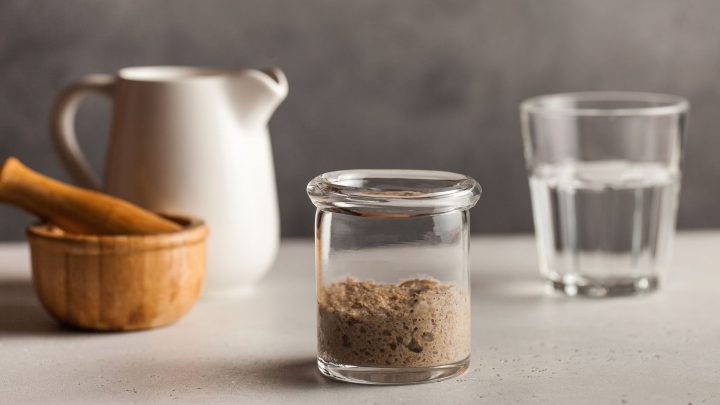
When is Your Sourdough Starter Mature Enough for the Fridge?
Putting your sourdough starter in the fridge before it’s ready can cause some complications.
You’ll have to prepare your starter for its temporary hibernation, by feeding it regularly at room temperature, twice a day until you have a mature starter. This can take up to 6 weeks (or more) but it’ll allow your starter to develop a strong yeast colony, and great flavor profile.
Before placing your starter in the fridge consider these questions:
- Are you working with a new sourdough starter?
- When you feed your starter does it double within 2 to 4 hours
A starter that’s less than 8 weeks old isn’t suitable for the fridge. Once you’re ready to bake again, adding fresh flour and water to your starter will ensure that your sourdough starter is ready to bake with, depending on what your recipe calls for.
Can You Use Refrigerated Starter Immediately?
Logically it is not advised to use your starter straight from the fridge, because you’ll be working with an inactive starter. This can cause many bread baking problems, which is why it’ll be more favorable to wake your starter before a bake. The way you do this will depend on how long your starter had been in the fridge, and how it responds when awoken.
- Less than 2 weeks
- More than 2 weeks
- 6 months+
Less than 2 weeks
If you fed your starter in the ration 1:2:2 before placing it into the fridge, remaining in the fridge for less than 2 weeks, then you won’t require much effort in awakening your starter.
If it’s only been a few days since your starter has been refrigerated, then place the jar on your kitchen counter, allowing it to warm up. This method works because the yeast and bacteria will not have consumed all the food in your starter yet.
Bring your starter to room temperature, and check your starter for a rise. A rise is a starter ready for baking with. A starter that was refrigerated for 2 weeks would mean that you should discard half and feed it once more before baking.
More than 2 weeks
A starter that has been refrigerated for more than 2 weeks, will be sleepy, but shouldn’t require much effort in awakening.
Take it out of the fridge and remove 25g of he cold starter, placing it into a clean jar. Feed this with 50g of flour and 50g of water, watch it double, then repeat.
If you notice that it doesn’t double, then keep feeding your starter with fresh flour and water until it does.
Your starter is ready to bake with when it has doubled, bubbled, and has a slightly domed top.
6 months+
A starter that has been kept in the fridge for more than 6 months, will most likely be in bad shape.
It may have developed a hooch which is a layer of liquid that forms on top of your starter, as an indication that an excess of alcohol has been produced, as a by-product of yeast fermentation. This usually happens when your sourdough starter hasn’t been fed for long periods.
As long as there’s no mold on your starter, then it can be revived simply by mixing it back into the starter, before discarding a small amount of starter, in time to feed it as you would normally.
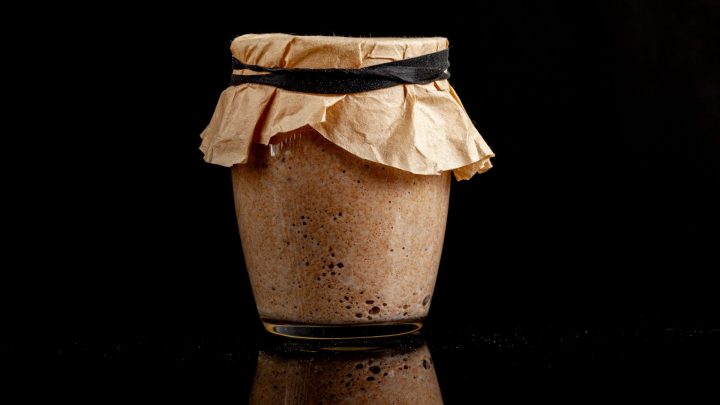
What Happens if I Leave My Sourdough Starter in the Fridge for a Long Time?
Fortunately, your starter will survive for quite a while in the fridge, even if you take a vacation for a few months and forget about it!
It may develop hooch, and release a sour – almost alcoholic smell, which is just an indication of the sourdough starter being very hungry. You can revive it by discarding some and feeding it again.
Some people have even managed to revive a starter from the fridge after 2 years! As long as there’s no mould, there’s always a possibility that your starter is good to bake with!
Drying Sourdough Starter
One of the easiest methods of storing your sourdough starter for longer periods is to dehydrate it. This is an incredibly simple process and once properly stored in an airtight container, the sourdough starter should last you a very long while!
Pros
- It’s simpler than refrigerating
- Doesn’t require any tools
- Lasts forever when stored properly
- Can share your starter
- Both starter and discard can become completely dry, ready for storage
Cons
- It may take a while
- Discard may require 1 to 2 extra feedings to be revived
- Recently fed starter is difficult to spread
- Dried starter broken into thick chunks, is more extensive to rehydrate vs a more powdered starter.
How to Store Sourdough Starter
- To dehydrate your sourdough starter, prepare a baking sheet lined with parchment paper
- Spread a generous heap of starter or discard in a thin layer
- Set the sourdough starter aside to dry, this can take up to 3 days. If you discover that the top layer of your dehydrating sourdough starter is hard and dry, then peel it from the parchment paper and flip it over, allowing the other side to dry for a further 24 hours
- Break the dried starter into thick chunks, and toss them in the blender or food processer, to turn into powder.
- Store your starter in an airtight container, in your pantry for as long as you desire.
How to Revive Sourdough Starter
- Start by adding 50g of your dehydrated starter to a large bowl, then pour 50g of warm water
- Allow it to sit and rehydrate for about 24 hours
- Weigh the mixture in the bowl, and start to feed your starter with a little more flour and water (about 50g each) every 24 hours until it begins to bubble, signaling that your starter is ready for making sourdough!
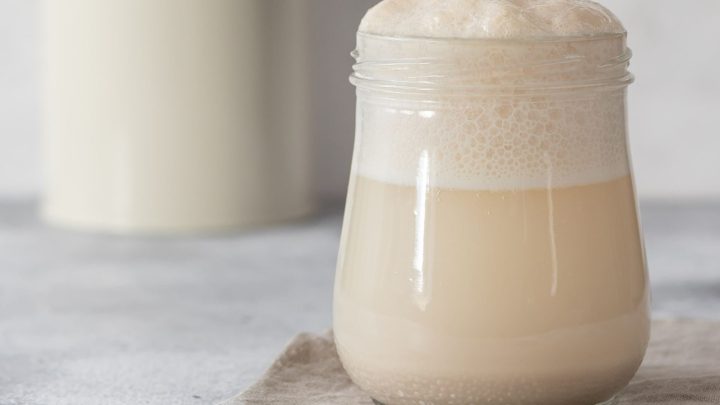
Can You Freeze Sourdough Starter?
If you wish to freeze your own sourdough starter for later use, you can. Frozen sourdough starter is great, as it preserves the natural flavors for up to 3 months while chilling in your freezer! Whether you choose to store it in an airtight container or freezer bag, bear in mind that your starter will have to defrost and warm up, before becoming active to feed again.
Storing Sourdough Starter in the Freezer
Freezing your sourdough starter is another option for those who wish to temporarily abort baking. Here are a couple methods to freeze your starter:
- Feed starter
- Once it begins to bubble, pour it into a freezer bag or container
- Seal and place it in the freezer (use a couple of freezer bags, sealing properly so that your starter is protected from freezer burn)
The second way to freeze your starter is to freeze it in small portions.
- In a large bowl, feed your starter with lots of flour and water (the idea is to make a large amount) then cover it with a cloth or loose lid
- After a few hours, you may notice some bubbling, and this is an indication for you to start dividing your starter into smaller portions (the amount you’d use for baking) You can use silicone muffin molds to make it easier for you, as they’ll pop right out
- After a few hours in the freezer, remove the sourdough starter from the muffin molds and store them in a freezer bag.
Reviving Sourdough Starter
- Remove your starter from the freezer and place it in the refrigerator, for at least a day
- Once your starter has thawed thoroughly, remove it from the fridge, and feed it some fresh flour and water regularly. It shouldn’t need more than 2 to 3 feedings before it becomes active once again
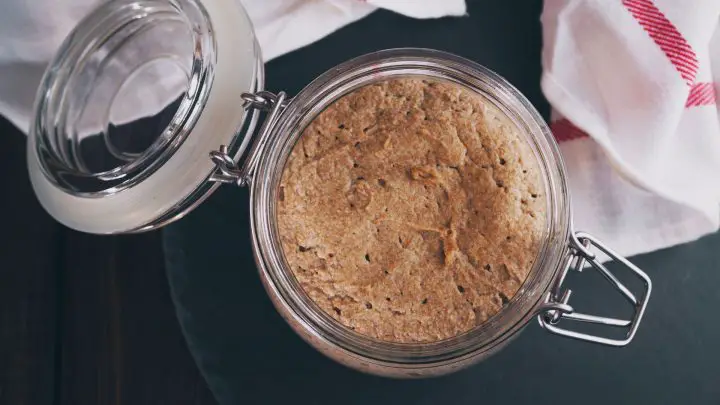
So, How to Store Starter?
Whether you choose to dehydrate, refrigerate, or freeze your sourdough starter, it all boils down to when you intend to bake again.
For longer vacation time, dehydrate your starter, as this will remain good indefinitely.
For weeks to months refrigerate or freeze your starter, then revive with fresh flour and water till its active and ready to bake with!
FAQs
How do you store sourdough starter long term?
If you wish to store your sourdough long term, then dry it. Spread your sourdough starter to dry until its completely brittle. Then break it into pieces, and store it in an airtight container.
Should I keep my sourdough starter in an airtight container?
While the surrounding temperature plays an important role to your sourdough starter, it does not need to be sealed in an airtight container. Though you should cover the starter with a lid, to prevent any mess from entering.
How long can you keep sourdough starter in the fridge?
You can keep a refrigerated sourdough starter for 3 to 4 days at a time between feedings. You should aim to feed your sourdough starter at least twice a week for best results.
What should I store my sourdough starter in?
You can store your sourdough starter in a glass jar, plastic container, pint jar, or stoneware crock.

